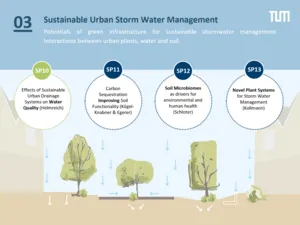Research cluster 3: Sustainable Urban Storm Water Management
Head: Brigitte Helmreich
Urbanization has disrupted or replaced natural hydrological processes due to the regulation of urban watercourses, sealing, and degrading of natural soils. This results in reduced evapotranspiration, less cooling, blocked infiltration, and frequent flooding. Moreover, sealed surfaces in rapidly expanding cities cause biodiversity losses and reduced ESS. They also cause transport and accumulation of pollutants originating from traffic areas, building materials, and industrial processes. Current technical solutions lead the stormwater runoff via the sewer system out of the cities and discharge it into sewage treatment plants or surface waters. However, under climate change, these systems need to be monitored and improved. In addition, these systems are challenged by more frequent and heavier rainstorms as well as extensive droughts.
Sustainable Drainage Systems (SUDS), which manage stormwater on-site, have been suggested as a measure to deal with these issues, and it is known that SUDS can retain, for example, heavy metals. So far, SUDS are designed from a technical and engineering perspective as infiltration systems without fully considering the potential of such systems to become hotspots of biodiversity, thus, generating positive feedback loops for the urban environment including for the mitigation of climate-related issues. Improved systems should take up large amounts of stormwater, deal with pollutants, prevent erosion, be drought-tolerant, and be covered by attractive vegetation with low maintenance costs. However, there is a lack of understanding of the techno-ecological characteristics of SUDS as elements of the UGI that provides multiple functions and ecosystem services. The challenge is to combine expertise in wastewater treatment and urban drainage with microbial ecology, soil science, restoration ecology and vegetation management.
We plan to generate biodiversity hotspots using SUDS in urban environments resulting in multiple ecosystem services provided by these structures. This includes reducing negative health impacts for humans living in urban environments, and in the long-run promoting urban horticulture. These aims require an in-depth understanding, which plants tolerate the specific site conditions at SUDS, including stress caused by extreme redox conditions, biocides, and heavy metals, and how the soil microbiome can support the growth of the target plants.
RC3 will investigate the uptake of urban stormwater run-off and the decontamination of pollutants by enriched sorption materials, the soil microbiome and plants in a three-staged approach. This should result in improved water purification, carbon sequestration, biodiversity, and food and flower production, as well as a more buffered urban climate by increasing evapotranspiration through specifically designed plant mixtures. The cluster will collaborate with Cluster 1 on opportunities of SUDS as multifunctional areas, e.g., for mobility systems.
These objectives are addressed by close interaction of four doctoral projects, which approach the topic from different perspectives. In addition to lab-scale experiments (stage 1 of every subproject), an experimental SUDS at semi-technical scale (stage 2) will be established where all doctoral candidates of RC3 will conduct their experiments in close collaboration, and then jointly review key aspects (water, soil, plants, microbes, micro-climate, pollutants) of the developed systems. For stage 2, we will utilize concrete rings (>20) with 1-m diameter and 1- m height at the TUM Campus Garching. Stage 3 will complete the program through investigations at the technical scale at already existing SUDS in various sites in Munich. Here, a Mercator Fellow (Dr. Deeb) with expertise in urban technosols and SUDS will be brought in to advise SUDS implementation especially in stage 3. Stages 1 and 2 will be established in the first year and monitored in the following years, while in the second year (stage 3) the baseline conditions of existing SUDS will be assessed in terms of biodiversity and ecosystem functioning. Also, new soil treatments and experimental communities will be established and analyzed in the third year, these treatments will also serve as the basis for new studies in the second cohort of doctoral projects the RTG.
The subprojects of research cluster 3 are

PI: Prof. Dr.-Ing. Brigitte Helmreich
PhD Candidate: Natalie Páez-Curtidor
Dissertation: Improvement of soil composition of SUDS for pollutant removal from stormwater run-off while maintaining the drainage function and enabling the implementation of plant biodiversity.
Background: SUDS are typically decentralized stormwater drainage systems with a focus on dewatering. In addition to the retention of pollutants, the improvement of water storage is of great interest to buffer flooding events and provide a cooling effect. It is also important, however, that SUDS do not cause health problems such as allergies due to accumulation of harmful substances. We hypothesize that multifunctional SUDS can be optimized for dewatering and absorbing pollutants from building facades, roofs and traffic areas (heavy metals, biocides, pesticides), while simultaneously benefitting urban biodiversity and climate. To do this, the soil composition and the thickness of the topsoil layer must be adapted. Soils rich in nutrients and the addition of sorption materials are supposed to help increase pollutant removal, while not compromising the main function of safe drainage and allowing for rich biodiversity. Investigations will be done at vegetated infiltration swales as examples of SUDS by examining various soil compositions enriched with carbon-rich and adsorptive substrates and the plant systems suggested by the subproject on soil functionality (SP11). The benefits for human health will be clarified in cooperation with the research on pollen and fungal spores (SP9). An extension of the SUDS enables to cover multiple other functions, e.g., for walking and cycling networks (SP2) and provides therefore a link to Cluster 1.
In this project, we will conduct experiments especially with high-carbon organic soil amendments (HCAs) in combination with nutrients aimed to improve urban soil structure and functionality (SP11), as well as sorption material enrichment for contaminant remediation.
We will study the uptake and degradation of pollutants from stormwater runoff at different weather conditions, and analyze the mobility of already retained pollutants using sequential extraction protocols.
The specific objectives are to:
(O1) Investigate the role of different soil amendment combinations to improve the removal of heavy metals and biocides;
(O2) Analyze the physico-chemical mechanisms responsible for the removal of pollutants;
(O3) Investigate the remobilization potential of pollutants in soil remediation strategies.
We predict that:
(H1) HAC additions with and without the addition of sorption materials will increase the removal rates for run-off pollutants;
(H2) An increase in the nutrient content in soil for plant growth, e.g., by the application of composts, will not affect the removal capacity for pollutants;
(H3) Trace organic chemicals are metabolized in the soil but can also be adsorbed, hence removal rate increases with soil amendment;
(H4) With soil amendment, heavy metals can be bound persistently as non-acid-extractable species;
(H5) Despite the enrichment of the soil with carbon-rich material and nutrients, the infiltration rate can be maintained through the additional sorption materials, i.e., the drainage security.
Methods: Experiments with different organic amendments in consultation with SP11 and different sorption material additions will be conducted to improve the removal capacity for pollutants in SUDS. In stage 1, we will use column tests to investigate the potential of soil mixtures and different abundant and cheap amendments (HCAs, iron oxide, lignite, ion exchanger biochar, etc.) for pollutants removal, i.e., heavy metals (Zn, Cu, Ni, Cd) and three biocides (diuron, mecoprop, terbutryn, and their metabolites). In stage 2, we will use vegetated infiltration swales implemented in outdoor plots at TUM Garching with the best soil mixes from stage 1 and plants from SP12 and SP13. The focus is the removal of pollutants and their remobilization under real conditions like heavy rain events and long dry weather periods. The influent for stage 2 experiments is biocide containing facade runoff as well as heavy metal runoff. We will determine soil organic carbon, water holding capacity, heavy metal and biocide contents as well as the degradation products of biocides in the soil matrix. In the third year, we will analyze the remobilization potential and the bioavailability of pollutants in the pre-stressed soils using sequential extraction protocols. In stage 3, we will analyze existing SUDS in Munich to test their contaminant content to thereby reduce contaminant risks associated with urban food gardening. We will also compare remobilization potential and bio-availability of pollutants already bound in SUDS and evaluate whether our improved soil composition could lead to an improvement. The project is intimately linked to appropriate plant systems (SP13), soil functionality (SP11) and soil micro-biomes (SP12).
Outlook: Large scale implementation of SUDS in the City of Munich will be studied in the Period II of the RTG.
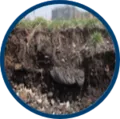
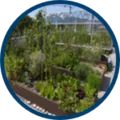
PI: Prof. Dr. Monika Egerer & Prof. Dr. Dr. Ingrid Kögel-Knabner
Affiliated researcher: Alexandra Zink
PhD candidate: Lauren Porter
Dissertation: Testing high-carbon amendments to boost urban soil functionality for UGI.
Background: The structural change in urban soils from natural soils affects the diversity of soil functions. The multifunctionality of strongly modified soils in the urban environment is essential for the control of biogeochemical processes. Although soil is inherently capable of buffering against perturbation, overloading the system in the urban environment poses a threat to various functions of urban soils.
Implementing large-scale SUDS programs requires new knowledge about the distribution and functional properties of soils relevant for the control of the respective plant systems and their ESS. The functionality of healthy soils, including serving as a growth medium and habitat, and contributing to the hydrologic cycle through adsorption, storage and supply of water, nutrients and contaminants, are intimately linked to the three-dimensional soil architecture, in turn controlled by the formation and structure of soil aggregates. Soil structural stability is a prerequisite for the functioning of SUDS, to guarantee infiltration capacity. Soil structure is essential for other SUDS functions, such as urban gardening, where soil contamination and water conservation are key objectives. New soil remediation tactics and water conservation strategies are needed to support above- and below-ground biodiversity and function that underlie ESS. Enhanced soil structure can improve soil remediation of contaminants for improved plant quality and water holding capacity to support diverse plant communities. Formation and stability of soil aggregate structure is strongly dependent on the continuous supply with organic matter from plant residues and rhizodeposits and their turnover by the soil microbial community. Previous experiments showed a high potential for artificial and immature soils to sequester carbon. The type of vegetation used and its root system control residue input to the soil and the microbial decomposition of the residues.
In urban environments, high-carbon amendments are common and cheap, such as lawn clippings and compost, with potential to boost soil carbon and structure. Yet it is unclear how different organic amendments can improve carbon sequestration and thereby water and soil contaminant binding, and how these benefits support multifunctional SUDS implementation.
In this project, we will conduct experiments using high-carbon organic soil amendments (HCAs) in combination with nutrients aimed to improve urban soil structure and soil functionality for contaminant remediation.
Our objectives are to
(O1) Investigate the role of different soil amendment combinations to improve soil carbon sequestration and the associated formation of soil structure;
(O2) Assess the ability of improved soil structure for soil water and contaminant binding for soil functionality;
(O3) Analyze the potential of HCA soil remediation strategies for above-ground plant communities and below-ground microbial communities for implementing UGIs such as wild flower strips and urban food gardens.
We predict that
(H1) HAC additions in combination with appropriate nutrients increase soil organic carbon storage;
(H2) Increases in soil carbon sequestration improve soil water and contaminant binding by amendment-induced boosts to soil C and C:N;
(H3) Strategic amendments in heavily impacted urban areas ameliorate conditions for implementing UGI systems that increase above- and below-ground biodiversity and functions.
Methods: Experiments with different organic amendments will be conducted to improve soil structure in SUDS, which in turn is considered to improve water and contaminant binding. In stage 1, we will use a recently developed soil incubation system that allows to investigate the potential of soil mixtures and different abundant and cheap amendments (HCAs: green waste, compost, biochar) for C storage and soil structure development. In stage 2, we will employ a split-plot design of multiple replicates to test how these high-carbon organic amendments improve water and contaminant binding in soils. In this phase we will join forces with the other projects within Cluster 3 at the experiment implemented in outdoor plots at TUM Garching where different plant composition is tested. Coupling the choice of waste mixture ratios and plants leads to a greater positive impact on soil functions than the choice of amendments alone. We will determine soil organic carbon, aggregate size and stability, water holding capacity, decomposition and specific target pollutant phases (Cu, Zn, Ni, Cd, Pb) as key indicators for improved soil structure and function in SUDS. In stage 3, we will implement strategies in Munich on plant systems to test how improved soil structure and function can promote e.g., plant functional diversity but also to reduce contaminant risks associated with urban food gardening. This field work is intimately linked to SP13 at SUDS with high water quality (SP10). The subproject will be co-led by Kögel-Knabner and Egerer for stages 1 and 2, while stage 3 will be mainly supervised by Egerer with support from Kögel-Knabner where needed, and a foreseen professorship for soil biophysical functioning will contribute when hired.
Outlook: In the Period II the SUDS approach will be linked with socio-ecological aspects of urban productive ecosystems.
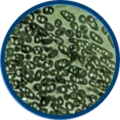
PI: Prof. Dr. Michael Schloter
Affiliated researchers: Dr. Stefanie Schulz, Safiya Yakubu
Dissertation: Modulating the microbiome of infiltration swales – Changes and risks for environmental- and human health.
Background: Soils are considered as a hotspot for microbial diversity, since 1 g of soil may harbor more than 109 microorganisms which belong to up to 5000 species. The enormous microbial diversity forms the basis for a large number of ESS provided by soils, including carbon sequestration, degradation of pollutants, safeguarding of drinking water resources, and support of plant growth. Besides, the resilience of soils is strongly linked to the dazzling array of bacteria, archaea, fungi and other eucaryotes. However, like for many other biotas, a strong decline in microbial richness has been observed in the past decades as a result of global change, which is often associated with a degradation of soils, and a loss of ecosystem functions. Recent studies indicate that reduced microbial diversity in the environment acts as a driver for several common diseases including infections and allergies. Thus, strategies are needed to stabilize the soil microbiome to improve both environmental and human health. In urban environments, such strategies are needed, as sealing and degradation and pollution of soils induce a strong decline in microbial diversity. Generating artificial biodiversity ‘hotspots’ in urban environments is therefore a valid mitigation strategy. So far, SUDS can be considered as ‘cold spots’ for biodiversity with spare or no vegetation, low microbial diversity and activity, and an overall lack of complex food web structures in the soil.
In the frame of this project, we want to test different strategies to improve microbial diversity and activity of SUDS, to generate positive feedback loops for these ecosystems, and to transform these cold spots into hotspots for biodiversity.
The objectives are:
(O1) Investigating improved nutrient status in SUDS for microbial diversity and activity;
(O2) Assessing the role of the soil microbiome of infiltration swales for improving stress tolerance of plants and the increase of above-ground biodiversity;
(O3) Describing the impact of soil biodiversity of SUDS for improved filtering of pollutants;
(O4) Analyzing the impact of heavy metals derived from metal roofs and rain pipes in combination with increased microbial activities (as a consequence of the improved nutrient status) for the coevolution of antibiotic-resistant microbes in the soil.
We predict that:
(H1) An increase in the nutrient content in the soil, e.g., by the application of composts, will induce shifts in the microbial stoichiometry of C:N:P:S and improve microbial activities;
(H2) Increases in microbial activity will indirectly (degradation of pollutants) and directly (improving stress tolerance) affect plant performance and increase plant diversity beyond hyperaccumulating plants for heavy metals;
(H3) An increase in plant diversity is associated with an increase in microbial diversity;
(H4) Enhanced microbial activities related to the degradation of biocides trigger the co-evolution of antibiotic-resistant microbiota in environments with high loads of heavy metals.
Methods: In close collaboration with SP10, SP11, and SP13 we will investigate various concepts to improve microbial biodiversity and ESS in SUDS. Stage 1 will analyze the consequences of the selected amendments described in SP10 and SP11 for the diversity of bacteria, fungi, archaea and protists, their functional traits as well as their activities. A special focus will be given to that microbiota, which is capable to degrade complex organic materials introduced as pollutants. To generate maximal synergies with SP10 and SP11, samples from the experiments performed in these two subprojects will be analyzed. In stage 2 we will assess the microbiome associated with the plants and plant mixtures proposed by SP13. We will compare the plant-associated microbiome of plants grown in soils with differing degrees of pollution to identify the microbiota that is most affected by pollution. It is planned to improve plant growth in SUDS by the application of selected bioinocula to substitute the functional traits of the most pollutant-sensitive microbiota. In stage 3 consequences of heavy metals and pollutants for the development of multi-drug resistant microbiota should be analyzed focusing on established SUDS. The risk of an increase of microbiota harboring genes for improved resistance against antibiotics located on mobile genetic elements should be described. To perform microbiome analysis in the three stages of the project, state-of-the-art molecular methods will be applied (e.g., barcoding, metagenomics, meta-transcriptomics). High throughput isolation-based methods will be applied to develop new bioinocula improving plant growth in polluted environments.
Outlook: In the Period II, the microbiome of SUDS will be investigated under field conditions in experimentally manipulated SUDS in the City of Munich.
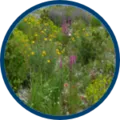
PI: Prof. Dr. Johannes Kollmann
Affiliated researcher: Dr. Markus Bauer
PhD Candidate: Nadja Berger
Dissertation: Bioengineering of trait-based plant communities for improved ecosystem functions of SUDS.
Background: Plant communities at SUDS have to be designed to provide at least some of the above-mentioned ESS, and innovative plantings should be based on theory of community assembly and trait-based restoration. Moreover, there are strong linkages between above- and below-ground processes, and vegetation structure and composition may modify below-ground functioning, including microbial communities, nutrient cycling and soil composition. Thus, the species-specific root systems affecting below-ground carbon storage, water retention and the interactions with microorganisms that degrade some pollutants, have to be taken into account when developing SUDS. This subproject will investigate plant communities using ecological criteria that combine water management, urban soil development, pollutant immobilization and biodiversity maintenance, and thus aims to boost synergies of ESS in SUDS, using ecological criteria.
The objectives are:
(O1) Designing experimental plant communities, using assemblage theory and below-ground functional traits, that improve the functioning of SUDS, while also providing biodiversity services, e.g., increasing resource offer and habitat for urban wildlife;
(O2) Investigating the role of root systems in water regulation, erosion control, pollutant stabilization or extraction, and identifying below-ground traits that enhance SUDS;
(O3) Analyzing and evaluating the relationship between below-ground traits of experimental plant communities on ecosystem processes such as water infiltration, nutrient cycling, carbon storage, and pollutant stabilization;
(O4) Evaluating large-scale experiments on both above- and below-ground ecosystem functioning and assessing the multifunctionality of newly established communities.
We predict that
(H1) Higher functional diversity of plant traits will increase below-ground ESS;
(H2) Trait-based plant communities show higher resistance against invasive alien plants;
(H3) Below- and above-ground functional diversity and the resulting ESS are correlated;
(H4) Small-scale patterns in functional diversity and ecological processes can be up-scaled.
Methods: At stage 1 we will grow individual plants of ten key species with contrasting root traits in 1-m depth tubes (10-cm diameter) on three substrates within climate chambers. We will include typical urban ruderal species (e.g., Echium vulgare and Leucanthemum vulgare) as well as plants that tolerate soil pollution (e.g., Armeria maritima und Silene vulgaris). In a factorial experiment, we will apply two climatic scenarios and two flooding regimes. Above-below-ground traits, root system development, and the potential ability to contribute to water infiltration, soil aggregate formation, and pollutant immobilization will be assessed. In stage 2 we will use mesocosms as larger experimental units. We will test the establishment of three experimental communities (15–20 species each), designed using below-ground traits. The communities will be exposed to three substrates and two watering regimes simulating the current rainfall amounts and heavy downpours. In stage 3 we will focus on 30–40 SUDS already existing in Munich and the surrounding area to implement and to test community establishment and multifunctionality. All in all, SP13 will investigate SUDS multifunctionality to understand the role of plant biodiversity for ecosystem services, i.e., water regulation or pollutant uptake and/or degradation. It will be developed in close cooperation with the three other subprojects within the research cluster including the use of common experimental set-ups and units. Additionally, interactions are expected with SP1 to improve the understanding of urban biodiversity networks.
Outlook: In Period II, the long-term dynamics of SUDS will be studied after experimental disturbance and invasion by unwanted woody and/or invasive non-native species.
